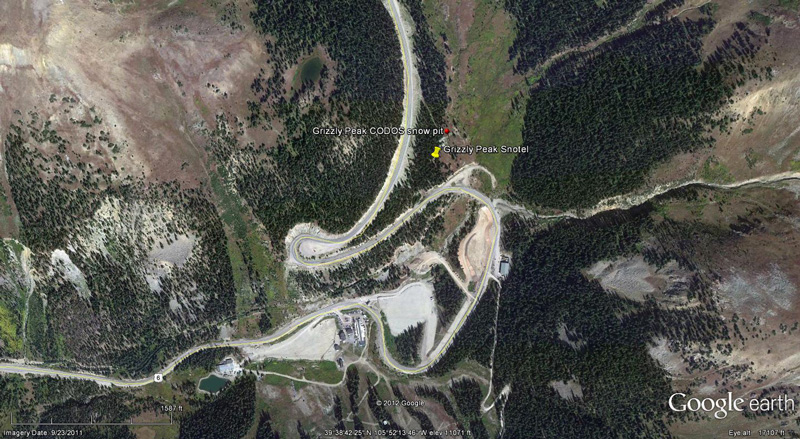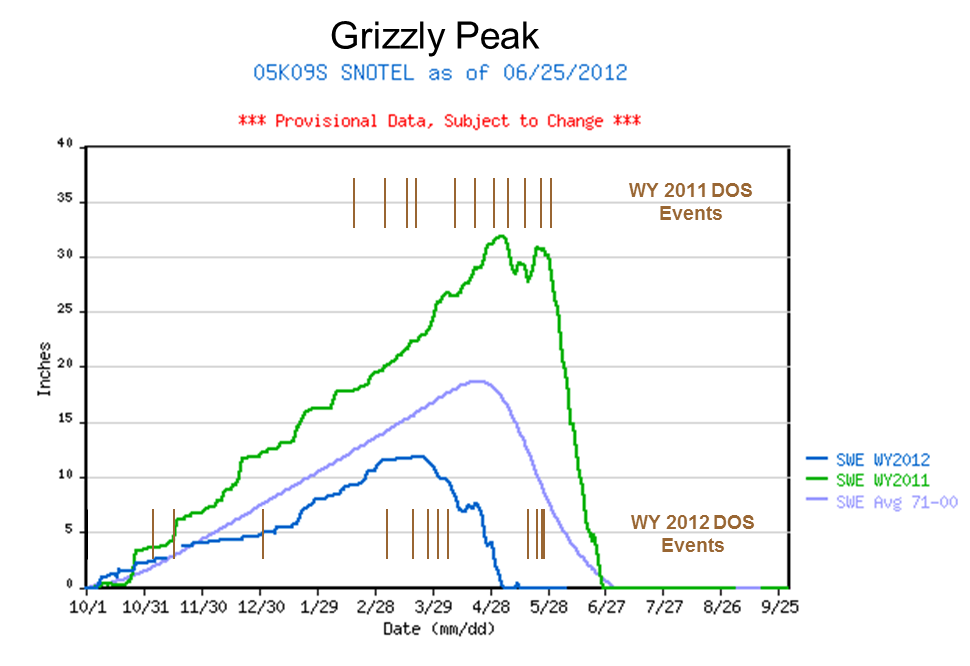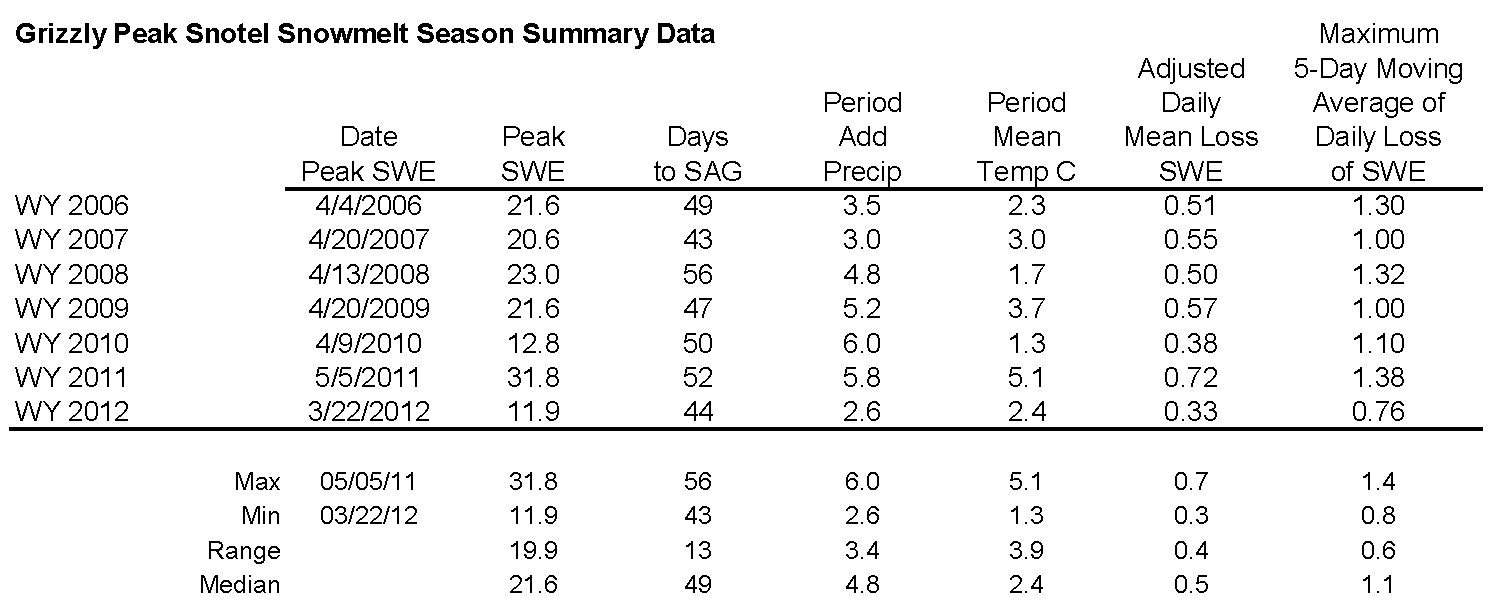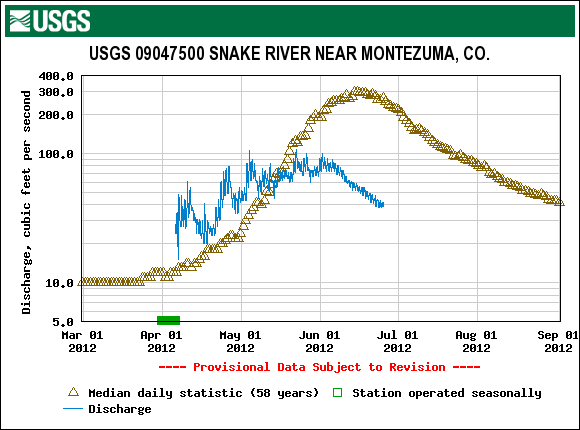 Water Year 2012 CODOS Summary
Water Year 2012 CODOS Summary
for Grizzly Peak
Summary | Snowpack | Melt Rate | Stream Flows
Summary
Water Years 2011 and 2012 are a case study in interannual variability of Colorado snowpack formation and ablation driven by vastly different late winter and spring weather conditions, perhaps representing seasonal extremes. In dramatic contrast with the unrelenting storms of Mar/Apr/May 2011, extremely dry late-winter and spring weather in 2012 resulted in low values of peak SWE, very early in the spring.
On the other hand, the past two seasons produced comparatively smaller differences in dust-on-snow conditions, with WY 2012 coming close to matching WY 2011 at the Senator Beck Basin Study Area, our baseline monitoring site. WY 2012 desert dust concentrations in the Loveland Pass and Grizzly Peak Snotel locale were only somewhat less intense than those observed at Senator Beck Basin. Very large areas of bare ground exposed for most of late winter and spring in Front Range mountains, including the Loveland Pass locale, may have also enabled larger amounts of local dust and vegetation debris to mix with desert dust than has occurred in prior seasons. In any event, whether because of desert or local dust, or both, spring 2012 snowpack warming was enhanced by minor reductions in snow albedo and the Grizzly Peak CODOS site snowpack became isothermal sometime in late March or early April. On April 10th the site was rapidly approaching “snow all gone” (SAG) with several dust layers merged at the snowpack surface. Streamflow data from the nearby USGS Snake River near Montezuma gauge document a substantial advance in snowmelt timing.
SnowPack & Dust Discussion

SWE accumulation and ablation for Water Years 2011 and 2012, with dust-on-snow events shown, by date, as brown bars for both water years (as observed at the Senator Beck Basin Study Area).
Water Year 2012 snowpack formation at the Grizzly Peak Snotel site began well but by early December had fallen well behind average accumulations into the lower quartile of SWE values for the period of record (see Snotel projection plot below). After rebounding just into the second quartile in mid-winter, peak SWE occurred very early, on March 22nd, at just 11.9”, well short of the 1971-2000 average of 18.6” and a full month earlier than the April 22nd average date of peak SWE. Peak SWE in 2011 was 31.8” and occurred on May 5th.
During WY 2011 eleven dust events occurred at Senator Beck Basin containing a total of 14 grams of dust per square meter. Most of those major dust layers were found in CODOS snow profiles that season at the Grizzly Peak CODOS site. However, relentless accumulation of late winter and spring snow routinely buried new dust layers and restored high snow albedo values throughout April and May, until the final and perhaps largest event of the season on May 29th.
Last season, during WY 2012, a similar twelve dust events occurred at Senator Beck Basin containing a total of ~10-12 grams of dust per square meter (see Senator Beck Basin Summary – Dust Log discussion). But, in a dramatic switch, late winter and spring 2012 were exceptionally dry, with widely spaced and comparatively small winter storms (see Senator Beck Basin – Winter Storm Log Discussion) leaving dust exposed at the snowpack surface for extended periods, beginning in early March.
In our March 15th snow profile at our Grizzly Peak CODOS site, we found event D4 dust at the surface of the 104 cm (41”) snowpack, with a tough melt/freeze crust at the snowpack surface. Despite that recent surface melt, the snowpack retained significant cold content on this date, with a mean snowpack temperature of -4.6° C.
By April 10th, our next snow profile at Grizzly Peak found the diminished 35 cm (14”) snowpack isothermal at 0° C and with wet snow throughout, with merged dust layers coinciding with events D8-D4 at the surface. SAG occurred shortly thereafter and, on our final CODOS site visit on May 2nd we hiked the east-facing slope from Hwy 6 to our snow-free CODOS site on dry ground. Several days later in the preceding season, on May 17th, 2011 the snowpack at the Grizzly Peak CODOS site was still 203 cm (80”) deep, with fresh snow at the surface and more snow to come later in the month.
The Grizzly Peak CODOS snowpit site on May 2nd, 2012 compared to a year earlier on May 17th, 2011, with CSAS’s Andrew Temple just getting started on the 80” deep snowpit.
Melt Rate

Analysis of Grizzly Peak Snotel data for 2006-2012 snowmelt seasons showing date and quantity of peak SWE, days from peak SWE to “snow all gone” (SAG), total additional precipitation after date of peak SWE, an “adjusted” mean daily rate of snowmelt adding the additional precipitation to the peak SWE total, the maximum five-day moving average of daily melt, and the mean air temperature over the entire snowmelt period, from peak SWE to SAG.
A view of the Grizzly Peak Snotel site approaching SAG on May 2nd, 2012. Although part of the snow pillow can be seen (closest to the camera), 4” of snow containing 1.3” of SWE were still being measured over the remainder of the pillow. Just 200’ away, on a generally level and open bench, the Grizzly Peak CODOS snowpit site (see photo above) had been snow-free for some time.
This discussion references CODOS Snotel site data and analyzes rates of snowmelt from Spring 2006 to the present, spanning the period during which we’ve rigorously observed dust-on-snow at our Senator Beck Basin Study Area, at Red Mountain Pass. Since the Snotel network is the only spatially extensive system continuously monitoring snowmelt throughout the Colorado mountains, year-to-year comparisons of Snotel melt rate data may yield insights into dust effects on local watershed-scale processes that our occasional CODOS snowpit measurements can’t reveal.
However, as we often note, many Snotel sites exhibit a radiative regime where surrounding trees reduce the access of incoming solar radiation to snowpack over the SWE measuring snow pillow, and where re-radiation of long wave energy from that vegetation and reduced skyview may inhibit radiant cooling and extend surface snowmelt during nighttime hours. The Grizzly Peak Snotel site exhibits these attributes although recent tree removal probably improved solar access somewhat. However, the site is still shaded by trees to the south and, as a consequence, does not experience the maximum effects of dust reductions in snow albedo, and short-wave radiative forcing, as compared to the adjacent open meadow and our CODOS snowpit site where solar access is comparatively unimpeded. This difference in dominant radiation regimes (long-wave in shady forests versus short-wave in sunny, open terrain) is routinely seen where snow-free open meadows immediately adjoin forest retaining snowpack, as was demonstrated at Grizzly Peak on May 2nd, 2012.
During WY 2012, three fall and early winter dust storms were observed low in the snowpack at Senator Beck Basin, and at least one of these layers (likely D3) was discernible at Grizzly Peak in our CODOS snow profiles. And, although WY 2012 dust-on-snow events D9-D12 fell well after the date of SAG at our Grizzly Peak CODOS site, those later events further reduced snow albedo and enhanced snowmelt rates in the remaining snow cover at higher elevations and on shady subalpine aspects in the nearby terrain.

WY 2012 SWE accumulation and ablation at Grizzly Peak Snotel with upper and lower quartiles of period of record shown in light grey, middle quartiles in dark grey surrounding median trace for period of record, and mean trace for 1971-2000 period.
Because of the early date of WY 2012 peak SWE at Grizzly Peak Snotel, on March 22nd, spring 2012 produced a two-step descending limb in the SWE plot rather than the single, steep plunge following the very delayed peak SWE in 2011. In 2012, snowpack ablation gradually accelerated in early April until storms in mid-April produced a small rebound in SWE. Then, in late April, under the influence of unseasonably warm temperatures and reductions in snow albedo from dust, melt rates accelerated again, to a higher rate. Overall, the Grizzly Peak Snotel site required 44 days to ablate 14.5” of SWE (including 2.6” of precipitation after peak SWE), averaging 0.33” of SWE loss per day.
Stream Flows

WY 2012 USGS Snake River near Montezuma Stream Gauge data for a 58 sq. mi. drainage area in the Snake River watershed, including the North Fork drainage, above 9,320’. Current year and historic data reflect minor diversions upstream for irrigation and domestic use.
Given the very dry spring and sub-par snowpacks throughout the Front Range mountains, below average snowmelt runoff in those watersheds was unsurprising. The Snake River near Montezuma hydrograph shows evidence of an early start to runoff with substantially above-average flows in April and a peak in early May. Additional surges later in May may have been enhanced by the final four dust-on-snow events of the season. As was typical throughout the state, runoff began a rapid decline in early June and by the end of June streamflows had fallen below those expected two months later, in September.
In addition to the very warm temperatures associated with prolonged periods of dry and sunny weather in late winter and spring 2012, dust-on-snow events D4 (March 6th) and D8 (April 6th) played a role in this early Snake River runoff, reducing snow albedo and hastening the ripening of the snowpack in late March, to isothermal. Dust then continued absorbing and adding solar energy to the snowmelt energy budget during subsequent periods of exposure at the snowpack surface in April and May. Additional dust events in late May, particularly D12 on May 26th, further reduced snow albedo in the scant remaining high elevation snowpack, hastening the extreme drying of Front Range mountain systems.
